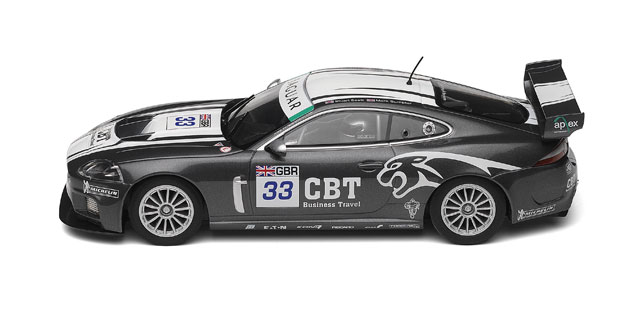A little va-va-voom
Scalextric – like jumpers for goal posts, scuffed knees and white dog mess – is a common childhood memory, although some of us find it hard to give up.
The small cars are still whizzing ‘round tracks in various models, whether classics from another era or current racers, like the new 1/32 scale Jaguar XKR GT3.

The scaled down vehicles, such as the new 1/32 scale Jaguar XKR GT3, have a great deal of accuracy and detail in their design
The scaled down vehicles have a great deal of accuracy and detail in their design, with this example fitted with a fully detailed interior, working front and rear lights, magnetic traction to help it stick to the track, and a device to switch between digital and analogue feed. Not something to let a drooling infant chew on.
The design team go to great lengths to cover the details as accurately as possible. Usually first contact is a meeting with the manufacturer and the vehicle where exact details of the car are taken. “We will take full measurements of every aspect of the car,” explains Darren Nye. “Overall dimensions of the wheelbase, height, width and length and also more finite details such as diameter of petrol caps and wheel nuts.”
Along with the measurements they take hundreds of photos, including interior shots, to ensure every conceivable angle, nook and cranny has been covered. “The most important of these photos are long distance shots of the car from the front, back, both sides and where possible overhead,” points out Darren. “These have to be taken from long range to eradicate as much perspective as possible and show a clear silhouette of the car’s shape.”
The images and the dimensions are imported into Pro/Engineer Wildfire, where they are used as a trace sketch outline with which to start creating the main body surfaces. Darren admits it’s a difficult process, taking six to eight weeks but even though manufacturers sometimes give them access to actual CAD data, this, and scanning an actual vehicle, is too much information for the surface model they wish to create.
Once the design is complete a rapid prototype model is commissioned and physical testing allows the team to check the fit of all components as well as its performance on the track.
“Providing the rapid prototype has not highlighted any modifications that need to be made, our CAD data is then sent to our manufacturers in China where they immediately set about creating the
mould tools.”
A unique technique, getting the right level of detail while still being able to attend to engineering factors like wall thickness is crucial to the process.
“The product needed to be completely accurate and highly detailed but designed in a way that it is functional, durable and at a price point that is suitable for both sets and solo release,” concludes Darren, as the mini Jag is added to the Scalextric family for future generations to become misty-eyed over.
Robot rock
With tooled-up robots like Johnny-5, Transformers, and even Arnie’s T-800 Terminator alter ego, a smiley toy robot for kids is not always the first to spring to mind.

As the owner plays with Roborover his personality shifts from shy to a more confident
Roborover from WowWee focuses on the other (less lethal) side of robots. His tracked locomotion and obstacle detection enables him to explore a room autonomously avoiding obstacles along the way. As the owner plays with Roborover his personality shifts from shy to a more confident and bold robot ready for adventure.
“All of our robots try to bring something more to the table than just being moving parts in plastic,” says Mike Gonzales, WowWee’s creative director. “WowWee wants create a deeper experience for the end user; robots that offer much more than just fifteen minutes of repeated motions, after which it ends up at the back of the closet.”
The original design came from sketches created by WowWee’s design team in Hong Kong working in conjunction with UK engineers, based on a combination of industrial machinery, some automotive and some sports shoe designs. “We wanted to make Roborover suitable for, and appealing to, younger users so aimed to avoid dirty exhaust stacks and sharp edges in the design.”
“We created a model in Rhino to test the practicalities of the design and asked a partner factory in China to produce a SolidWorks file to create a prototype.” The team found that the design would be too expensive for production, so made changes in the Rhino model. “This meant we could continue to use the same design language and other parts of the original design,” adds Mike.
Hypershot was used to produce renderings to evaluate design and colour and to present to management and for marketing. However, more interesting was the team’s use of Maya to produce an animation to aid with the timing of the voice and how the light animations would look in the final product.
www.WowWee.com

The latest in toy technology, including the design behind Scalextic






